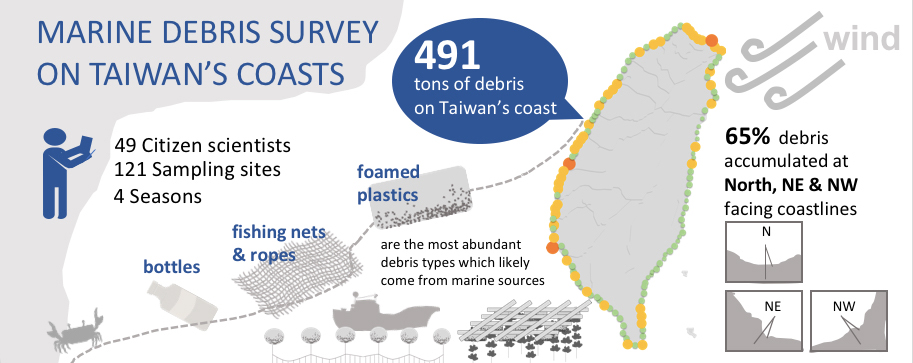
摘要
持續監測海廢的分佈與組成,是有效管理海岸與淨灘所不可或缺的。我們訓練49位公民科學調查員,在2018至2019年在台灣本島1210公里海岸線,進行4次的海廢快篩調查。全台共121處樣站,每個樣站取100公尺作為樣區,紀錄海廢體積與體積量最多的三類型廢棄物。發現台灣本島2018至2019年的平均海廢密度為每公里406.6公斤,而最多的三種海廢為塑膠瓶罐、發泡塑膠,和漁網與繩索。
統計分析後發現,面北(正北、東北與西北)的海岸線比其他面向的海岸線有顯著較高的垃圾量,我們認為是強勁的東北季風所導致。我們也發現,當使用體積作為計量單位時,漁業相關廢棄物明顯比使用件數計算時的量高出許多。海廢的平均污染程度與風速、海岸類型,以及與特定的污染源距離有關。
我們的結果可與日韓的快篩調查相比較,三處的海廢皆高度聚集在少數高污染的海岸段。因此,視覺評估的快篩方法,可作為在高污染海岸的有效淨灘指引,也能應用在累積可信的長期監測數據。
Abstract
Ongoing monitoring of the distribution and composition of coastal debris is a prerequisite for efficient management and cleanups. Therefore, we conducted a rapid assessment of coastal debris along the 1210 km coastline of Taiwan using a visual estimation method. Forty-nine citizen scientists were intensively trained to correctly identify the volume and types of debris. At 121 sampling locations randomly placed along Taiwan’s coastline, the citizen scientists recorded the pollution level and the three most abundant debris types within a 100-m transect during four surveys in 2018-2019.
Averaging over the four surveys, the mean amount of coastal debris was estimated to be 406.6 kg/km, and the three most abundant debris types were plastic bottles, foamed plastics, and fishing nets and ropes. Using a statistical test which avoids spatial pseudoreplication, we showed that north-facing coastlines had significantly higher pollution levels than the other coastlines, which we suggest is deposited there during strong winter winds. We also showed that fishery-related debris was a much more important part of coastal debris when the volume of it was determined instead of just the number of items. Mean pollution levels were further associated with wind speed, coastline type, and the distance to presumed pollution sources. Our results compare well with similar surveys conducted in Japan and South Korea. In each country, the debris was highly aggregated, which means it was concentrated in a few highly polluted localities. Therefore, the visual estimation method can effectively guide cleanup efforts to the most polluted areas and also reliably generate long-term monitoring data.
Yen, N., Hu, C. S., Chiu, C. C., & Walther, B. A. (2022). Quantity and type of coastal debris pollution in Taiwan: A rapid assessment with trained citizen scientists using a visual estimation method. Science of The Total Environment, 153584.
